Weide Liu
Integrating SAM Supervision for 3D Weakly Supervised Point Cloud Segmentation
Aug 27, 2025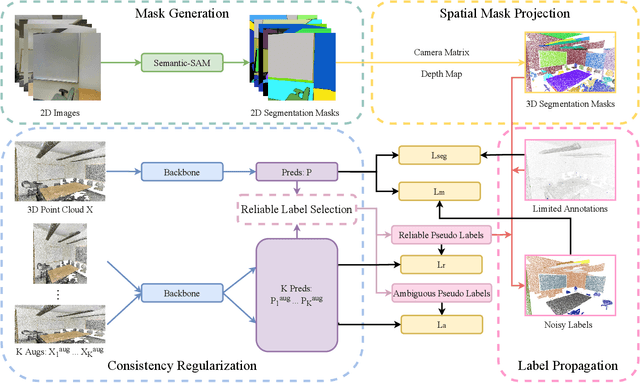
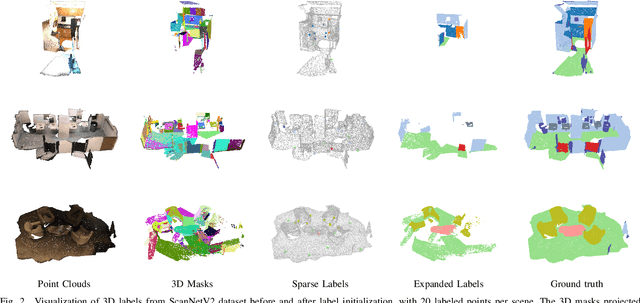
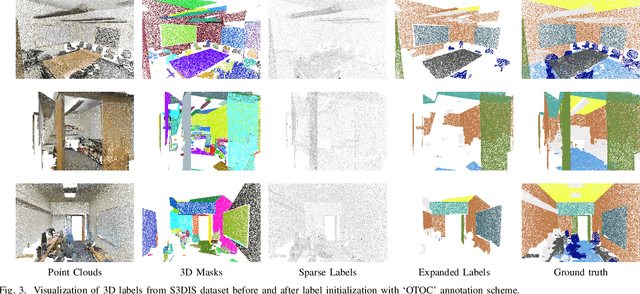
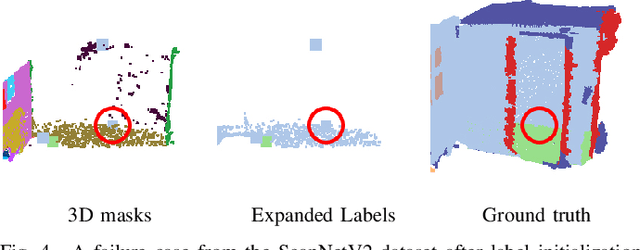
Abstract:Current methods for 3D semantic segmentation propose training models with limited annotations to address the difficulty of annotating large, irregular, and unordered 3D point cloud data. They usually focus on the 3D domain only, without leveraging the complementary nature of 2D and 3D data. Besides, some methods extend original labels or generate pseudo labels to guide the training, but they often fail to fully use these labels or address the noise within them. Meanwhile, the emergence of comprehensive and adaptable foundation models has offered effective solutions for segmenting 2D data. Leveraging this advancement, we present a novel approach that maximizes the utility of sparsely available 3D annotations by incorporating segmentation masks generated by 2D foundation models. We further propagate the 2D segmentation masks into the 3D space by establishing geometric correspondences between 3D scenes and 2D views. We extend the highly sparse annotations to encompass the areas delineated by 3D masks, thereby substantially augmenting the pool of available labels. Furthermore, we apply confidence- and uncertainty-based consistency regularization on augmentations of the 3D point cloud and select the reliable pseudo labels, which are further spread on the 3D masks to generate more labels. This innovative strategy bridges the gap between limited 3D annotations and the powerful capabilities of 2D foundation models, ultimately improving the performance of 3D weakly supervised segmentation.
Modality-Aware Feature Matching: A Comprehensive Review of Single- and Cross-Modality Techniques
Jul 30, 2025



Abstract:Feature matching is a cornerstone task in computer vision, essential for applications such as image retrieval, stereo matching, 3D reconstruction, and SLAM. This survey comprehensively reviews modality-based feature matching, exploring traditional handcrafted methods and emphasizing contemporary deep learning approaches across various modalities, including RGB images, depth images, 3D point clouds, LiDAR scans, medical images, and vision-language interactions. Traditional methods, leveraging detectors like Harris corners and descriptors such as SIFT and ORB, demonstrate robustness under moderate intra-modality variations but struggle with significant modality gaps. Contemporary deep learning-based methods, exemplified by detector-free strategies like CNN-based SuperPoint and transformer-based LoFTR, substantially improve robustness and adaptability across modalities. We highlight modality-aware advancements, such as geometric and depth-specific descriptors for depth images, sparse and dense learning methods for 3D point clouds, attention-enhanced neural networks for LiDAR scans, and specialized solutions like the MIND descriptor for complex medical image matching. Cross-modal applications, particularly in medical image registration and vision-language tasks, underscore the evolution of feature matching to handle increasingly diverse data interactions.
Attribute-formed Class-specific Concept Space: Endowing Language Bottleneck Model with Better Interpretability and Scalability
Mar 26, 2025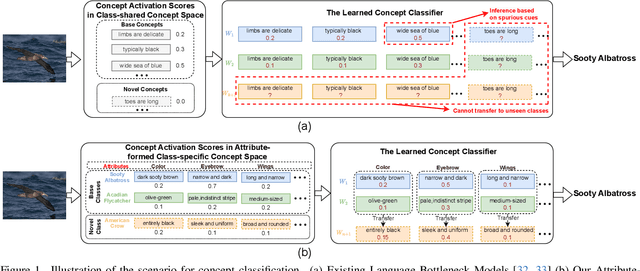

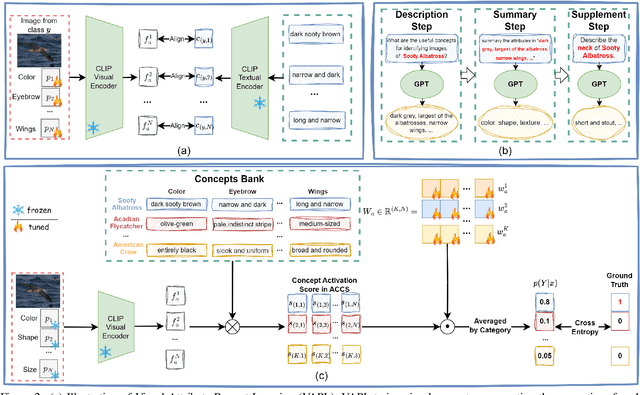

Abstract:Language Bottleneck Models (LBMs) are proposed to achieve interpretable image recognition by classifying images based on textual concept bottlenecks. However, current LBMs simply list all concepts together as the bottleneck layer, leading to the spurious cue inference problem and cannot generalized to unseen classes. To address these limitations, we propose the Attribute-formed Language Bottleneck Model (ALBM). ALBM organizes concepts in the attribute-formed class-specific space, where concepts are descriptions of specific attributes for specific classes. In this way, ALBM can avoid the spurious cue inference problem by classifying solely based on the essential concepts of each class. In addition, the cross-class unified attribute set also ensures that the concept spaces of different classes have strong correlations, as a result, the learned concept classifier can be easily generalized to unseen classes. Moreover, to further improve interpretability, we propose Visual Attribute Prompt Learning (VAPL) to extract visual features on fine-grained attributes. Furthermore, to avoid labor-intensive concept annotation, we propose the Description, Summary, and Supplement (DSS) strategy to automatically generate high-quality concept sets with a complete and precise attribute. Extensive experiments on 9 widely used few-shot benchmarks demonstrate the interpretability, transferability, and performance of our approach. The code and collected concept sets are available at https://github.com/tiggers23/ALBM.
Diffusion-based Facial Aesthetics Enhancement with 3D Structure Guidance
Mar 18, 2025Abstract:Facial Aesthetics Enhancement (FAE) aims to improve facial attractiveness by adjusting the structure and appearance of a facial image while preserving its identity as much as possible. Most existing methods adopted deep feature-based or score-based guidance for generation models to conduct FAE. Although these methods achieved promising results, they potentially produced excessively beautified results with lower identity consistency or insufficiently improved facial attractiveness. To enhance facial aesthetics with less loss of identity, we propose the Nearest Neighbor Structure Guidance based on Diffusion (NNSG-Diffusion), a diffusion-based FAE method that beautifies a 2D facial image with 3D structure guidance. Specifically, we propose to extract FAE guidance from a nearest neighbor reference face. To allow for less change of facial structures in the FAE process, a 3D face model is recovered by referring to both the matched 2D reference face and the 2D input face, so that the depth and contour guidance can be extracted from the 3D face model. Then the depth and contour clues can provide effective guidance to Stable Diffusion with ControlNet for FAE. Extensive experiments demonstrate that our method is superior to previous relevant methods in enhancing facial aesthetics while preserving facial identity.
Multitask Auxiliary Network for Perceptual Quality Assessment of Non-Uniformly Distorted Omnidirectional Images
Jan 20, 2025Abstract:Omnidirectional image quality assessment (OIQA) has been widely investigated in the past few years and achieved much success. However, most of existing studies are dedicated to solve the uniform distortion problem in OIQA, which has a natural gap with the non-uniform distortion problem, and their ability in capturing non-uniform distortion is far from satisfactory. To narrow this gap, in this paper, we propose a multitask auxiliary network for non-uniformly distorted omnidirectional images, where the parameters are optimized by jointly training the main task and other auxiliary tasks. The proposed network mainly consists of three parts: a backbone for extracting multiscale features from the viewport sequence, a multitask feature selection module for dynamically allocating specific features to different tasks, and auxiliary sub-networks for guiding the proposed model to capture local distortion and global quality change. Extensive experiments conducted on two large-scale OIQA databases demonstrate that the proposed model outperforms other state-of-the-art OIQA metrics, and these auxiliary sub-networks contribute to improve the performance of the proposed model. The source code is available at https://github.com/RJL2000/MTAOIQA.
Video Quality Assessment for Online Processing: From Spatial to Temporal Sampling
Jan 13, 2025Abstract:With the rapid development of multimedia processing and deep learning technologies, especially in the field of video understanding, video quality assessment (VQA) has achieved significant progress. Although researchers have moved from designing efficient video quality mapping models to various research directions, in-depth exploration of the effectiveness-efficiency trade-offs of spatio-temporal modeling in VQA models is still less sufficient. Considering the fact that videos have highly redundant information, this paper investigates this problem from the perspective of joint spatial and temporal sampling, aiming to seek the answer to how little information we should keep at least when feeding videos into the VQA models while with acceptable performance sacrifice. To this end, we drastically sample the video's information from both spatial and temporal dimensions, and the heavily squeezed video is then fed into a stable VQA model. Comprehensive experiments regarding joint spatial and temporal sampling are conducted on six public video quality databases, and the results demonstrate the acceptable performance of the VQA model when throwing away most of the video information. Furthermore, with the proposed joint spatial and temporal sampling strategy, we make an initial attempt to design an online VQA model, which is instantiated by as simple as possible a spatial feature extractor, a temporal feature fusion module, and a global quality regression module. Through quantitative and qualitative experiments, we verify the feasibility of online VQA model by simplifying itself and reducing input.
TINQ: Temporal Inconsistency Guided Blind Video Quality Assessment
Dec 25, 2024Abstract:Blind video quality assessment (BVQA) has been actively researched for user-generated content (UGC) videos. Recently, super-resolution (SR) techniques have been widely applied in UGC. Therefore, an effective BVQA method for both UGC and SR scenarios is essential. Temporal inconsistency, referring to irregularities between consecutive frames, is relevant to video quality. Current BVQA approaches typically model temporal relationships in UGC videos using statistics of motion information, but inconsistencies remain unexplored. Additionally, different from temporal inconsistency in UGC videos, such inconsistency in SR videos is amplified due to upscaling algorithms. In this paper, we introduce the Temporal Inconsistency Guided Blind Video Quality Assessment (TINQ) metric, demonstrating that exploring temporal inconsistency is crucial for effective BVQA. Since temporal inconsistencies vary between UGC and SR videos, they are calculated in different ways. Based on this, a spatial module highlights inconsistent areas across consecutive frames at coarse and fine granularities. In addition, a temporal module aggregates features over time in two stages. The first stage employs a visual memory capacity block to adaptively segment the time dimension based on estimated complexity, while the second stage focuses on selecting key features. The stages work together through Consistency-aware Fusion Units to regress cross-time-scale video quality. Extensive experiments on UGC and SR video quality datasets show that our method outperforms existing state-of-the-art BVQA methods. Code is available at https://github.com/Lighting-YXLI/TINQ.
Streamline tractography of the fetal brain in utero with machine learning
Aug 26, 2024



Abstract:Diffusion-weighted magnetic resonance imaging (dMRI) is the only non-invasive tool for studying white matter tracts and structural connectivity of the brain. These assessments rely heavily on tractography techniques, which reconstruct virtual streamlines representing white matter fibers. Much effort has been devoted to improving tractography methodology for adult brains, while tractography of the fetal brain has been largely neglected. Fetal tractography faces unique difficulties due to low dMRI signal quality, immature and rapidly developing brain structures, and paucity of reference data. This work presents the first machine learning model for fetal tractography. The model input consists of five sources of information: (1) Fiber orientation, inferred from a diffusion tensor fit to the dMRI signal; (2) Directions of recent propagation steps; (3) Global spatial information, encoded as distances to keypoints in the brain cortex; (4) Tissue segmentation information; and (5) Prior information about the expected local fiber orientations supplied with an atlas. In order to mitigate the local tensor estimation error, a large spatial context around the current point in the diffusion tensor image is encoded using convolutional and attention neural network modules. Moreover, the diffusion tensor information at a hypothetical next point is included in the model input. Filtering rules based on anatomically constrained tractography are applied to prune implausible streamlines. We trained the model on manually-refined whole-brain fetal tractograms and validated the trained model on an independent set of 11 test scans with gestational ages between 23 and 36 weeks. Results show that our proposed method achieves superior performance across all evaluated tracts. The new method can significantly advance the capabilities of dMRI for studying normal and abnormal brain development in utero.
Gaussian Mixture based Evidential Learning for Stereo Matching
Aug 05, 2024



Abstract:In this paper, we introduce a novel Gaussian mixture based evidential learning solution for robust stereo matching. Diverging from previous evidential deep learning approaches that rely on a single Gaussian distribution, our framework posits that individual image data adheres to a mixture-of-Gaussian distribution in stereo matching. This assumption yields more precise pixel-level predictions and more accurately mirrors the real-world image distribution. By further employing the inverse-Gamma distribution as an intermediary prior for each mixture component, our probabilistic model achieves improved depth estimation compared to its counterpart with the single Gaussian and effectively captures the model uncertainty, which enables a strong cross-domain generation ability. We evaluated our method for stereo matching by training the model using the Scene Flow dataset and testing it on KITTI 2015 and Middlebury 2014. The experiment results consistently show that our method brings improvements over the baseline methods in a trustworthy manner. Notably, our approach achieved new state-of-the-art results on both the in-domain validated data and the cross-domain datasets, demonstrating its effectiveness and robustness in stereo matching tasks.
Enhancing Incomplete Multi-modal Brain Tumor Segmentation with Intra-modal Asymmetry and Inter-modal Dependency
Jun 14, 2024



Abstract:Deep learning-based brain tumor segmentation (BTS) models for multi-modal MRI images have seen significant advancements in recent years. However, a common problem in practice is the unavailability of some modalities due to varying scanning protocols and patient conditions, making segmentation from incomplete MRI modalities a challenging issue. Previous methods have attempted to address this by fusing accessible multi-modal features, leveraging attention mechanisms, and synthesizing missing modalities using generative models. However, these methods ignore the intrinsic problems of medical image segmentation, such as the limited availability of training samples, particularly for cases with tumors. Furthermore, these methods require training and deploying a specific model for each subset of missing modalities. To address these issues, we propose a novel approach that enhances the BTS model from two perspectives. Firstly, we introduce a pre-training stage that generates a diverse pre-training dataset covering a wide range of different combinations of tumor shapes and brain anatomy. Secondly, we propose a post-training stage that enables the model to reconstruct missing modalities in the prediction results when only partial modalities are available. To achieve the pre-training stage, we conceptually decouple the MRI image into two parts: `anatomy' and `tumor'. We pre-train the BTS model using synthesized data generated from the anatomy and tumor parts across different training samples. ... Extensive experiments demonstrate that our proposed method significantly improves the performance over the baseline and achieves new state-of-the-art results on three brain tumor segmentation datasets: BRATS2020, BRATS2018, and BRATS2015.
 Add to Chrome
Add to Chrome Add to Firefox
Add to Firefox Add to Edge
Add to Edge